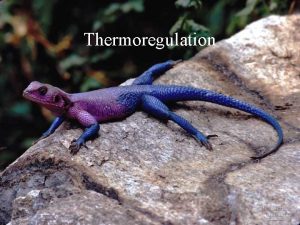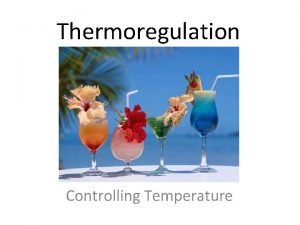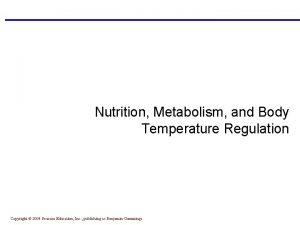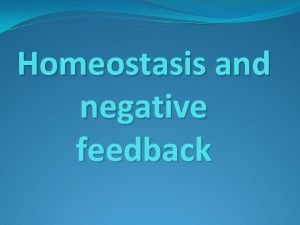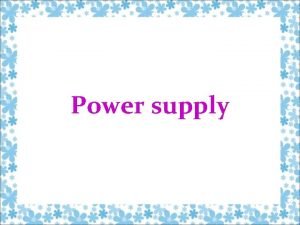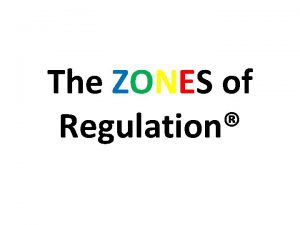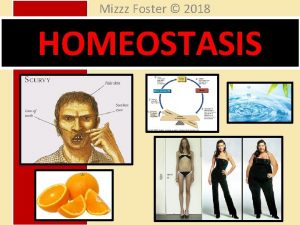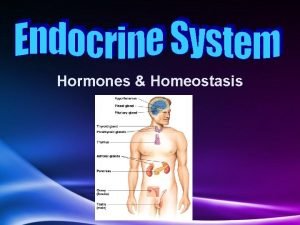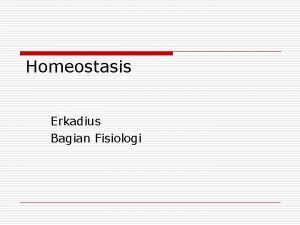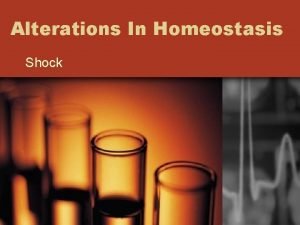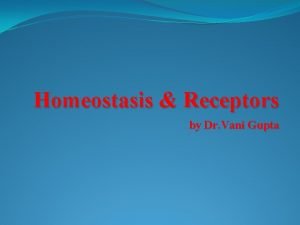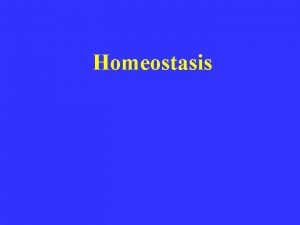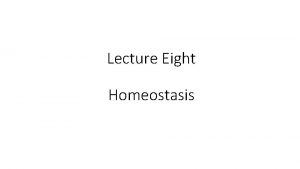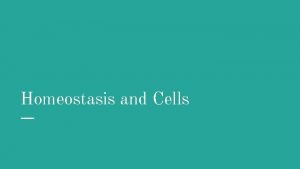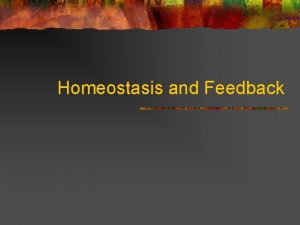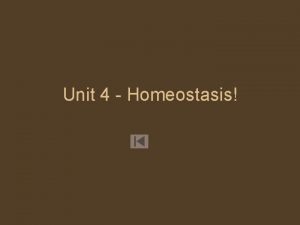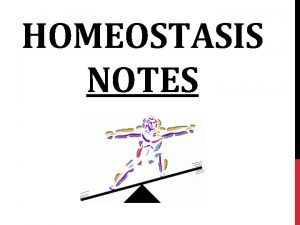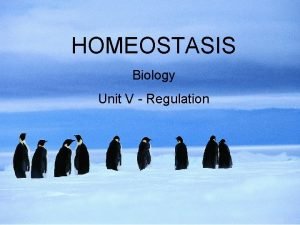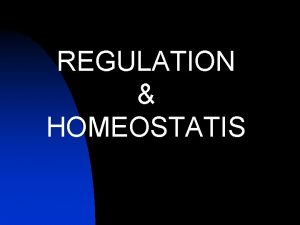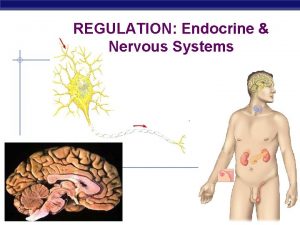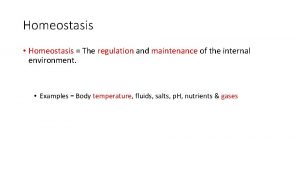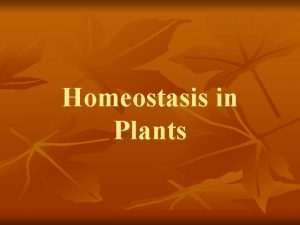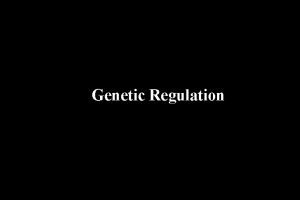Homeostasis What is Homeostasis Homeostasis is the regulation





















































- Slides: 53

Homeostasis

What is Homeostasis ? ● Homeostasis is the regulation and maintenance of the internal environment of the body. ● Conditions within the body must remain within a narrow range, like your body temperature. ● Homeostasis involves keeping the internal environment within set ranges ● This is achieved through the interaction and coordination of two body systems - the Endocrine and Nervous systems

● The endocrine system is composed of glands that produces chemical messengers called hormones. ● Hormones are produced in one part of the body and travel to target organs through the bloodstream.

Glands and Hormones Gland Hormone Produced Effects Hypothalamus Antidiuretic hormone Acts on the kidney to regulate fluid balance Pituitary 9 different hormones Growth and regulates other glands Thyroid Thyroxine Metabolism Pancreas Insulin & glucagon Blood sugar Adrenal Epinephrine Heart rate & blood pressure Testes Testosterone Sperm & male characteristics Ovaries Estrogen & progesterone Eggs & female characteristics

● The brain continuously sends signals to the endocrine glands to secrete and release hormones and the glands, in turn, send feedback to the nervous system. ● The hypothalamus in the brain is the master switch that sends signals to the pituitary gland which can release up to eight hormones into the bloodstream. ● The hormone travels to its target organ and usually results in the release of another hormone into the bloodstream.

NERVOUS SYSTEM The function of the human nervous system is to control and coordinate functions throughout the body. It does this by responding to internal and external stimuli. A stimulus is a signal from inside or outside the body. It can be chemical or electrical in nature. A response is a signal sent to reply to the stimulus.

The Nervous System consists of : Brain Spinal cord Neurons Nerves

PARTS OF THE NERVOUS SYSTEM The basic unit of the nervous system is the Neuron. Messages are picked up from the environment or other neurons by the dendrites and are sent to the cell body; which contains most of the cytoplasm of the cell.

The neuron acts like an electric wire. • Electrical impulses travel through the axon (wire). • The axon is insulated by the Myelin sheath which prevents the impulse from leaving the neuron. • Messages leave the neuron through the axon terminals where they are sent to other neurons.

WHAT IS A SYNAPSE? The gaps between the axon terminal of one neuron and the dendrites of another are called synapses.

WHAT HAPPENS AT THE SYNAPSE? • As an electrical impulse travels to the axon of a neuron it stimulates the release of neurotransmitters. These are contained in small vesicles at the axon terminals. • The neurotransmitter molecules move across the synapse and attach themselves to receptors on the membrane of the next neuron. • A neurotransmitter is a chemical that carries messages between different nerve cells or between nerve cells and muscles.

3 TYPES OF NEURONS Sensory Neurons Pick up stimuli from the outside environment or from inside the body. These are found in organs called receptors (skin, eyes, ears, nose, tongue, and glands. ) They transmit the message to interneurons. Interneurons Receive messages from the sensory neurons and interpret them. They then decide where they should be sent. Motor Neurons Receive messages from interneurons and sends them to organs called effectors (muscles and glands).

REFLEX ARC

Feedback Mechanisms and Homeostasis

Feedback Mechanisms Feedback is a way for the body to maintain homeostasis by comparing current conditions to set ranges. There are two types of feedback situations: ● Negative feedback stops the change ● Positive feedback increases the change

Regulation of Blood Glucose Negative Feedback loop ● Glucose intake occurs during digestion of food that is needed for energy expenditure to perform routine physical activities. ● The pancreas is the key organ that regulates the glucose levels in body by secreting two hormones, insulin and glucagon. ● The liver also helps to store the excess glucose in form of glycogen to be utilized later.

Glucose and Insulin Negative Feedback Loop The opposite actions of these two hormones, insulin and glucagon, helps to maintain normal blood sugar levels in the body hence maintain homeostasis of the body.

Diabetes is a disease in which the body is unable to properly use and store glucose (a form of sugar). Glucose backs up in the bloodstream — causing one’s blood glucose (sometimes referred to as blood sugar) to rise too high.

There are two major types of diabetes. • In type 1 diabetes, the body completely stops producing any insulin, a hormone that enables the body to use glucose found in foods for energy. • People with type 1 diabetes must take daily insulin injections to survive. This form of diabetes usually develops in children or young adults, but can occur at any age.

Type 2 diabetes results when the body doesn’t produce enough insulin and/or is unable to use insulin properly (insulin resistance). This form of diabetes usually occurs in people who are over 40, overweight, and have a family history of diabetes, although today it is increasingly occurring in younger people, particularly adolescents.

BLOOD SUGAR (GLUCOSE) REGULATION NEGATIVE FEEDBACK ENDOCRINE SYSTEM CONTROLLED

Regulation of body temperature Negative Feedback Loop • Animals that are capable of maintaining constant internal body temperatures are said to be warmblooded. • Increased temperature causes vasodilatation (blood vessels near the surface of the skin dilate). • The large surface area allows heat to be lost from the blood and lowers the body temperature. • Sweating also helps lower the temperature.

• Decreased temperature causes vasoconstriction (blood vessels contract) and minimal heat loss occurs which helps maintain body temperature. • Hair on the body provides insulation and helps maintain body temperature by creating ‘goosebumps’.

Body Temperature Negative Feedback Nervous System and Endocrine system response

Childbirth (Positive Feedback ) ● During labor, a hormone called oxytocin is released that intensifies and speeds up contractions. ● The increase in contractions causes more oxytocin to be released and the cycle goes on until the baby is born. ● The birth ends the release of oxytocin and ends the positive feedback mechanism.

Childbirth Positive Feedback

● Another good example of a positive feedback mechanism is blood clotting. ● Once a vessel is damaged, platelets start to cling to the injured site and release chemicals that attract more platelets. ● The platelets continue to pile up and release chemicals until a clot is formed.

Blood Clotting Positive Feedback

Immune Response

Immune System • It’s role is to protect you from foreign invaders. ● Special cells react to each kind of pathogen with defensive tactics targeted specifically at that type of pathogen. • A pathogen is a bacterium, virus, or other microorganism that can cause disease.

What is Immunity? • Immunity is a state in which the body has sufficient defenses to fight infection, disease or invasion by bacteria, viruses or any other toxins. • Non- Specific Immunity refers to the defenses that are in place at all times and are not specific to the invader to which the system is responding. It would include your skin, mucous membranes, hairs in nose and ears, enzymes in mouth and tears in eyes.

Non-specific immunity would include your skin, mucous membranes, hairs in nose and ears, enzymes in mouth and tears in eyes.

Specific Immunity is a specific antibody response to an invader and has been acquired in one of several ways. Antibodies are special proteins that recognize and defeat invading pathogens. • Antibodies were transferred from mother to fetus across the placenta. • Antibodies were transferred through breast milk from mother to child. • Antibodies were built up due to prior exposure to the pathogen. • Antibodies were built up through a vaccination process.

What is a Vaccination? • A vaccination is the injection of a killed or weakened pathogen that produces immunity in the body against that pathogen. • Vaccines DO NOT contain the type of pathogen that makes you sick. • Having this little bit of the pathogen inside your body makes your body's immune system build antibodies to it. • Vaccinations can be given by a needle, mouth and some through a nasal spray.

In the USA children are vaccinated before they can enter school for: Measles, Mumps, Rubella, Pertussis, Hepatitis A & B, Diphtheria, Tetanus and varicella

Specialized Immune System Cells ● White blood cells(WBC)are colorless cells that circulate in the blood and body fluids and are involved in fighting foreign substances and diseases. ● Macrophages are special WBCs that kill invaders by swallowing them. When it sees an unwelcome invader, it changes shape so that it can swallow it. ● It then holds it inside a cage so it can't escape! When the cage door closes, nasty chemicals are released, which destroy the trapped invader.

• T- Cells are a high-ranking type of WBC. They are the commanders of your immune system. They co-ordinate all the other cells in your immune system in the battle against infection, telling them to "seek and destroy" all foreign invaders. All T cells originate from stem cells in your bone marrow. • HIV is a virus. It is much more dangerous than other viruses like colds and flu, because it can lead to acquired immunodeficiency syndrome (AIDS). HIV's full name is human immunodeficiency virus. It is a retrovirus that infects the T-cell commanders of your immune system army.

● B-Cells are another type of WBC. Some mature into plasma cells and drop antibody 'bombs' to blow up foreign invaders. ● Some B cells mature into memory B cells. Once a pathogen is encountered by the B-cells it memorizes the antigens on it and next time it encounters the pathogen it will have antibodies ready to fight the pathogen.


Lymphatic System The lymphatic system is an extensive drainage network that helps keep bodily fluid levels in balance and defends the body against infections. It filters out organisms that cause disease, produces certain white blood cells and generates antibodies.

Major Parts of the Lymphatic System • It is made up of a network of lymphatic vessels that carry lymph — a clear, watery fluid that contains protein molecules, salts, glucose, urea, and other substances — throughout the body. • It works closely with the immune system and the circulatory system. • The Spleen is an organ that stores many of the white blood cells needed for the immune response.

Allergic Response

● Allergies are a major cause of illness in the United States. ● 50 million Americans, including millions of kids, have some type of allergy. ● Allergies account for the loss of an estimated 2 million school days per year. ● An allergy is an overreaction of the immune system to a substance that's harmless to most people. The symptoms can range from annoying to life threatening.

An allergic response is an overreaction to a harmless substance ( an allergen. )

Allergen is any antigen that causes an allergy. It may be: ● ● contracted through the skin inhaled through the lungs injected swallowed

● Your immune system overreacts to the antigen by producing antibodies called Immunoglobulin E , or Ig. E. ● These antibodies travel to special Mast cells that release chemicals, causing an allergic reaction. Mast cells release histamine, a powerful inflammatory agent. ● This reaction usually causes symptoms in the nose, lungs, throat, sinuses, ears, lining of the stomach or on the skin.

● Each type of Ig. E has specific "radar" for each type of allergen. ● That's why some people are only allergic to cat dander (they only have the Ig. E antibodies specific to cat dander) ● While others have allergic reactions to multiple allergens because they have many more types of Ig. E antibodies.


What is anaphylactic shock? Anaphylactic shock, also called anaphylaxis, is a severe, life-threatening reaction to certain allergens. Body tissues may swell, including tissues in the throat. Anaphylactic shock is also characterized by a sudden drop in blood pressure. The following are the most common symptoms of anaphylactic shock. However, each individual may experience symptoms differently. Other symptoms may include: ● Itching and hives over most of the body ● Swelling of the throat and tongue ● Difficulty breathing ● Dizziness ● Headache ● Stomach cramps, nausea, or diarrhea ● Shock ● Loss of consciousness

Skin Allergy Tests

Asthma and Allergies ● The same allergens that give some people sneezing fits and watery eyes can cause an asthma attack in others. ● Allergic asthma is the most common type of asthma. ● The symptoms that go along with allergic asthma show up after you breathe things called allergens (or allergy triggers) like pollen, dust mites, or mold. ● If you have asthma (allergic or nonallergic), it gets worse after you exercise in cold air or after breathing smoke, dust, or fumes. Sometimes even a strong smell can set it off.

allergens. Once they get into your body, your immune system overreacts. The muscles around your airways tighten. The airways become inflamed and over time are flooded with thick mucus. Whether you have allergic asthma or nonallergic asthma, the symptoms are generally the same. You’re likely to: ● Cough ● Wheeze ● Be short of breath ● Breathe quickly

 Countercurrent exchange thermoregulation
Countercurrent exchange thermoregulation Thermoregulation
Thermoregulation Temperature regulation
Temperature regulation Negative and positive feedback mechanism of homeostasis
Negative and positive feedback mechanism of homeostasis Bioflix activity homeostasis low blood glucose
Bioflix activity homeostasis low blood glucose Bioflix activity homeostasis hormones and homeostasis
Bioflix activity homeostasis hormones and homeostasis Bảng số nguyên tố lớn hơn 1000
Bảng số nguyên tố lớn hơn 1000 đặc điểm cơ thể của người tối cổ
đặc điểm cơ thể của người tối cổ Vẽ hình chiếu vuông góc của vật thể sau
Vẽ hình chiếu vuông góc của vật thể sau Các châu lục và đại dương trên thế giới
Các châu lục và đại dương trên thế giới Chụp tư thế worms-breton
Chụp tư thế worms-breton ưu thế lai là gì
ưu thế lai là gì Hệ hô hấp
Hệ hô hấp Tư thế ngồi viết
Tư thế ngồi viết Cái miệng nó xinh thế chỉ nói điều hay thôi
Cái miệng nó xinh thế chỉ nói điều hay thôi Mật thư tọa độ 5x5
Mật thư tọa độ 5x5 Bổ thể
Bổ thể Tư thế ngồi viết
Tư thế ngồi viết Thế nào là giọng cùng tên?
Thế nào là giọng cùng tên? Thẻ vin
Thẻ vin Thể thơ truyền thống
Thể thơ truyền thống Các châu lục và đại dương trên thế giới
Các châu lục và đại dương trên thế giới Chúa yêu trần thế alleluia
Chúa yêu trần thế alleluia Hươu thường đẻ mỗi lứa mấy con
Hươu thường đẻ mỗi lứa mấy con Từ ngữ thể hiện lòng nhân hậu
Từ ngữ thể hiện lòng nhân hậu Diễn thế sinh thái là
Diễn thế sinh thái là Vẽ hình chiếu vuông góc của vật thể sau
Vẽ hình chiếu vuông góc của vật thể sau 101012 bằng
101012 bằng Tỉ lệ cơ thể trẻ em
Tỉ lệ cơ thể trẻ em Lời thề hippocrates
Lời thề hippocrates đại từ thay thế
đại từ thay thế Quá trình desamine hóa có thể tạo ra
Quá trình desamine hóa có thể tạo ra Công thức tính độ biến thiên đông lượng
Công thức tính độ biến thiên đông lượng Các môn thể thao bắt đầu bằng tiếng chạy
Các môn thể thao bắt đầu bằng tiếng chạy Sự nuôi và dạy con của hổ
Sự nuôi và dạy con của hổ Thế nào là mạng điện lắp đặt kiểu nổi
Thế nào là mạng điện lắp đặt kiểu nổi Hình ảnh bộ gõ cơ thể búng tay
Hình ảnh bộ gõ cơ thể búng tay Dạng đột biến một nhiễm là
Dạng đột biến một nhiễm là Thế nào là sự mỏi cơ
Thế nào là sự mỏi cơ Vẽ hình chiếu đứng bằng cạnh của vật thể
Vẽ hình chiếu đứng bằng cạnh của vật thể Phản ứng thế ankan
Phản ứng thế ankan Voi kéo gỗ như thế nào
Voi kéo gỗ như thế nào Thiếu nhi thế giới liên hoan
Thiếu nhi thế giới liên hoan điện thế nghỉ
điện thế nghỉ Một số thể thơ truyền thống
Một số thể thơ truyền thống Thế nào là hệ số cao nhất
Thế nào là hệ số cao nhất Trời xanh đây là của chúng ta thể thơ
Trời xanh đây là của chúng ta thể thơ Ng-html
Ng-html Line regulation
Line regulation Ga healthcare facility regulation division
Ga healthcare facility regulation division Malate aspartate shuttle
Malate aspartate shuttle Regulation and inspection of social care wales
Regulation and inspection of social care wales Water balance regulation
Water balance regulation Zones of regulation youtube
Zones of regulation youtube
